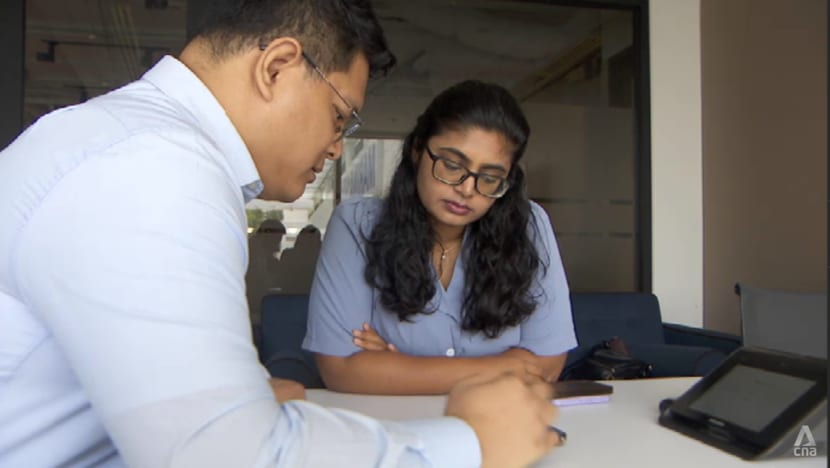More migrant workers able to get timely treatment through telemedicine services: Healthcare providers

Telehealth providers have tried to make their services easy to use and remove language barriers.

This audio is generated by an AI tool.
SINGAPORE: There has been a steady increase in migrant workers using telemedicine services in the past two years, according to medical service providers.
Fullerton Health, for instance, is currently seeing about 3,000 such patients digitally each month.
Since 2022, the healthcare group has provided over 60,000 online consultations using their telemedicine app.
Doctors said telehealth services increase convenience and accessibility, and ensure migrant workers can seek timely medical attention.
This is because consultations can be done outside regular working hours, which are crucial for workers on shift work schedules.
Telemedicine also allows workers, some of whom reside far away from healthcare facilities, to consult doctors from their dormitories.
“This saves on time and costs associated with travelling to a clinic,” said Dr Lee Ming Yong, Fullerton Health’s medical director of clinical services.
“It also improves productivity, as workers do not need to take time off work to consult a doctor in-person for non-urgent medical issues.
TELEHEALTH FOR MIGRANT WORKERS
Telemedicine service is provided for under a basic care plan for migrant workers introduced in 2021. A year later, it became mandatory for employers to buy the plan for their workers.
Under the programme, four healthcare providers were identified as anchor operators, covering six sectors in Singapore. They are: Fullerton Healthcare, SATA CommHealth, StarMed Specialist Centre and St Andrew's Mission Hospital.

| Sector | Appointed anchor operator | Location of medical centre for migrant workers | Selected on-site medical centres within dormitories |
| A | StarMed Specialist Centre | StarMed Specialist Centre @ Farrer Park | Not Applicable |
| B | SATACommHealth | 63 Loyang Way | Not Applicable |
| C | SATACommHealth | Woodlands Recreation Centre | PPT Lodge 1B |
| D | SATACommHealth | Kranji Recreation Centre | Sungei Tengah Lodge |
| E | Fullerton Healthcare Group | 47 Gul Circle | Tuas View Dormitory & CDPL Tuas Dormitory |
| F | St Andrew’s Mission Hospital | Penjuru Recreation Centre | Not Applicable |
The aim was to ensure access to healthcare for the 442,000 migrant workers in the nation.
Since then, providers have tried to make their services easy to use and remove language barriers.
For example, Fullerton Health engages with employers to provide workers with user guides on how to register and utilise its telemedicine services.
These user guides come in English, Mandarin, Bengali, Tamil and Hindi. Translation is also available within its telemedicine application.
The providers said steps are being put in place to ensure that the system is accessible to even more workers.
OVERCOMING CHALLENGES
However, some providers cited persistent challenges such as getting some employers to accept electronic medical certificates (MCs).
Dr Ho Chin Swee, lead for the Migrant Workers Medical Centres at SATA CommHealth, a charitable healthcare organisation, said communication is key to allay such concerns.
"Employers may contact us for verification. All it takes is for us to just communicate with them that telemedicine is also proper clinical care. When we explain it to them, usually they're quite accepting of it,” he said.
Most workers whom the non-profit caters to are in the construction, marine shipyard and process sectors, and they constantly face manual material handling, the use of power tools, and are exposed to the elements such as heat.
The centre’s doctors are trained to identify the severity of each patient’s symptoms over telehealth apps, and react accordingly, said its deputy lead Dr Khang Hock Siang.
“The nature of their jobs … usually results in muscular conditions, carpal tunnel, tendonitis, injuries, and even skin conditions from exposure to chemicals and irritants,” he told CNA’s Singapore Tonight programme.
Mild symptoms without any red flags can be handled over tele-consultations, where doctors will give advice remotely and medications can be sent to the workers’ dormitories.
For more serious conditions such as injuries, or if there is a need to do a physical check such as blood pressure, doctors will advise patients to a physical clinic.
CONCERNS OVER MCs
To allay concerns by employers that workers could take MCs too frequently, providers have adopted some measures.
They said those with a record of frequently using telehealth services will be told to visit physical clinics instead.
“Sometimes, it might be an underlying undiagnosed condition or even a mental health condition. We will refer them to our physical clinics where we can do the appropriate examinations,” said Dr Khang.
“What I would say is: if your workers present with concerns about their health, let them be seen by a healthcare worker. And if need be, discuss with the workers and healthcare providers on what can further be explored,” he added.
Providers said they are trying to reach out to more workers to use their telehealth apps. They are also widening their services to offer other forms of support, such as mental health and physiotherapy.


















